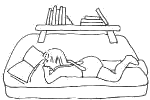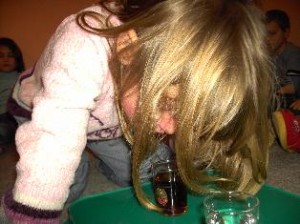Lecture at the 4 th IHVO-Symposium on May 5 th , 2007
by Silvia Hempler
Reading and writing in kindergarten?
That’s a clear “yes” for me.
Before I elaborate on this I would like to say a few words about who I am and where I work. I have been managing the Municipal Kindergarten Sedanstraße in the city of Remscheid for a year, after having been the assistant manager for a number of years there. In March of 2006 we attained the status of “Integrative Focus Kindergarten for the Advancement of Gifted Children” by IHVO-Certificate. There are 9 Kindergarten teachers working and living with 90 children in our house. Three of these colleagues have received their personal certificates in 2005. One further colleague is presently attending a certificate course. The entire staff (and I am including two members of staff who have left) approved of and supported these further training efforts.
More details on the course of the IHVO-Project can be found here:
The Municipal Kindergarten Sedanstraße and Its Becoming an Integrated Focus Kindergarten for the Advancement of Gifted Children
Our facility is situated in a residential area with people of many nationalities. The range of developmental states among our children is rather wide. We have always had to respond rather individually to our children’s diverging developmental states.
Five years ago a diagnosed gifted child was the reason for us to begin asking a lot of questions as to how we could meet this child’s extraordinary needs. Looking for answers we came across the possibility for further trainings on the topic.
Taking small but steady steps we have since then managed to greatly improve our efforts to meet the needs of gifted children in our daily work.
I would like to introduce the topic “Reading and Writing in Kindergarten” by telling you a story:
Story: Actually Things Aren’t Going All That Bad
>Even as a baby I felt awkward. “Time to go sleep, kid”, said my mother. She really did think I had the time to sleep.
So I screamed as loud as I could, and there I had a new strategy that would prove helpful many more times to come. Why won’t the boy sleep? This and my screaming made my parents take me to a doctor. “The boy is OK”, determined the physician.
My parents still wouldn’t stop consulting experts. Weird, really.
What’s more, my parents wanted things that never crossed my mind. Going outside to play, for example. What in the world was I to do with a shovel, a bucket and some sand??? I was really keen on the things dad had, they were much more exciting, but I was too small for that. “Pat a cake”, my mother sang. “Good idea”, said I, “I know a book, it tells how to do it, let’s go inside.”
”Oh well”, said my mother and left me sitting on the pile of dirt.
Next, I was being introduced to a group of children. “They’re all your age”, my mother grinned. “OK, let’s play doctor”, that was something I knew.
I always had a stethoscope on me. After some screaming by me and the other children I heard mum say “Oh well”, and it wasn’t long before I was back on my little pile of dirt.
‘A new place, a whole new ball game’ is what my mother must have been thinking when she took me to a kindergarten. I had my strategy so there was nothing to fear. Except: they had a pile of dirt, a shovel and a bucket, too.
Today, at a mature 3,5 years, I have learned to put up with the dirt. I have even come to appreciate it. We built an hour glass with it. Now I can flip it when the afternoon circle is finished and see when my mother is going to be there to pick me up. Every so often I implement my strategy, most of the time it’s no good, though. I still think it’s weird what some of the kids do, but that’s alright. My parents are OK now, too. I have my father’s tools now, and when my mother is tired, I read out a story to her. I learned that at kindergarten.
Actually, things aren’t going all that bad.
The story illustrates how important good observation is, how important it is to consider the living situation of children and parents, and how important it is to recognise the children’s inclinations and talents. This is true for all children and it is especially true for gifted children. As in the story, “Pat a cake” might prompt many a gifted child to rather go about baking a real cake by recipe, weighing out the ingredients, instead of making a mud cake with toy cake pans. It is now up to the kindergarten teacher to observe and recognise these interests and together with the child look for ways to play them out.
Experience shows that a good realisation of such projects can be managed with all the children in the group or even across different groups. For gifted children chances to find like-minded children increase if they get to participate in activities in other groups as well, which they can do any time in our house. That’s how they come to see that they are not alone with their modes of learning and going about things, they meet the most different individuals.
One of our major methods is working in projects. Projects, always aiming to an end –whatever that may be -, require the most different kinds of talents in order to be completed successfully. This ensures that gifted children can get involved in shared activities and all children of our facility get to make all kinds of experiences, which each child can profit from in its very own way.
That is precisely what is meant by ‘integrative work’.
Project „Reading Club“
The Reading Club was a spin-off of another project – the Dragon Club. The participating children were 4 to 6 years of age.
In the course of the projects “Feelings” and “What I can do and what I would like to learn to do” the wish to learn how to write emerged among the children.
The photographs show in what different ways the children were writing and making their experiences.
They copied from info leaflets hanging on the walls, they copied the names from the name tags in the washing room, they cut out letters and laid words with them …
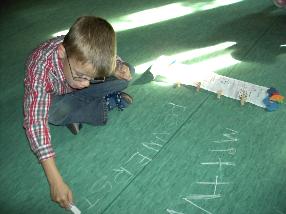 … writing on the floor of the gym with chalk.
… writing on the floor of the gym with chalk.
Soon those children, who showed greater interest in learning how to write and how to read as well, emerged.
Two children approached me with this request, a five-year-old and a four-year-old. It turned out to be these two who made the quickest learning progress.
All in all it started with 6 children who wanted to join the Reading Club. Over time three of them dropped out and two joined the club later.
At first we didn’t set a fixed time for the sessions of the club which resulted in the children’s asking me all the time if I couldn’t read with them. Surely, everybody will understand that there are a great many more duties to be taken care of by me, so that we eventually agreed on one weekly session. Now it wasn’t the question, “Could you read with us?”, all the time, now it was, “Is today Friday?”.
From experience I know that it is very important for gifted children to have clear objectives and to pursue them decidedly, not too slowly and not too playfully. For the Reading Club we agreed on clear objective:

Together we want to learn how to read.
How did we go about it?
Upon my initial question, “What do we need for learning how to read?”, the children answered: “letters.” No big surprise, the topic of letters had been dealt with already. These very interested children had all written the complete alphabet on cardboard and cut the letters out. Good for them.
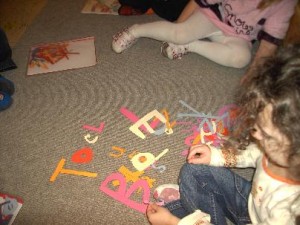 We went straight into the matter and tried to figure out how far we were with this. Which letters were known, which weren’t.
We went straight into the matter and tried to figure out how far we were with this. Which letters were known, which weren’t.
It worked really well when we checked this by playing a Kim’s-Game.
It went like this: Some cut out letters were positioned under a blanket. One child would then touch one and try to feel which letter it was and name it.
At this point of the learning process it is important to distinguish between the name of the letter and the sound the letter stands for.
For example we would say “s” [only the hiss] instead of “es” or “b” instead of “bee”. This was important for the children to understand, because without this intermediate step the children were not able to recognise the letters.
Whenever a child couldn’t determine the letter by groping it or when it couldn’t name it correctly it would take the letter home. I had told the children that without a firm knowledge of the letters one wouldn’t be able to learn how to read, which prompted one child to take the letter home for practicing. The other children adapted this immediately and one child who had an older brother coined the term “homework” for this.
I was under the impression that everybody felt taken seriously in their wish to learn how to read. They felt I had confidence in their ability to complete a given homework and thereby close in on their goal. And it really worked, all children learned the letters well and quickly.
When this was done I conveyed to the children that these letters can be put together in words which will then make sense.
However, my explanation that to a person, who could read, the word “flower” would be of the same meaning as a picture of a flower, did not seem to make any sense to the children.
This became comprehensible only after we had “given life” to the letters by looking at them as little figures, little people. All letters became little figures. We still called them b, c, f and so forth.
The decisive step was then that the single letters would hold hands, team up so to say, and thereby became words. We tried it.
 The most talented children (whose idea it was to learn reading) could manage this immediately. They didn’t have much of a problem joining the letters to form words.
The most talented children (whose idea it was to learn reading) could manage this immediately. They didn’t have much of a problem joining the letters to form words.
The older one of the two (Paula – name changed) had – as I was suspecting – already understood how reading works, but she hadn’t had the courage to reveal this. The four-year-old had learned it just then during the project.
The other children in the Reading Club needed more time to make sense of the concept of joining letters, and it took them yet more time to grasp such combinations of letters as “ch” or “sch”. It was great to see how the older girl kept helping these children. I also appreciated the four-year-old (Rosi) who was so preoccupied with her own learning process.
Bring on the books?!
Then it became clear: if you want to read, you need books. The choice of a book which everybody liked and everybody was able to read turned out to be a problem. I realised that the children laid great emphasis on the idea: I can read what I have written . The children just couldn’t agree on a book so one girl finally said: “So, let’s make our own book.” Everybody liked the idea.
The title, which was proposed along with this idea by that same child, was immediately accepted.
At the very fore was the text itself. So we went about developing a text. We met in the office where we chose a PowerPoint layout. Paula (5 years) made suggestions for the text which I typed in until Rosi (4 years) took turns with me by asking “Can I …?”. When she made a typing mistake the spelling checker would mark the wrong word red. Upon a short explanation she understood that she had to change the spelling of the word. For example the word “sid” – she articulated it once more and realised that it had to be spelled with a “t”.
At each session of the Reading Club we would add some new text and then the children drew pictures to go with it.
 Especially Rosi took great pride in getting new assignments each time which had to do with reading and writing. For example, she kept asking for practice sheets and asked a lot of questions. She also came to my office many times in order to work on the book on her own. The best thing about it was being able to say “I’ll be in the office”.
Especially Rosi took great pride in getting new assignments each time which had to do with reading and writing. For example, she kept asking for practice sheets and asked a lot of questions. She also came to my office many times in order to work on the book on her own. The best thing about it was being able to say “I’ll be in the office”.
„A D, an O, and an R, is T the next one ???
 The Reading Club made me the expert for reading and writing in the eyes of the children.
The Reading Club made me the expert for reading and writing in the eyes of the children.
After a few pages were finished the children’s focus shifted from writing more text to getting the book done. We then began to look at how a book is made technically.
We met a bookbinder who still does the bookbinding manually and we were allowed to visit her.
Now we could finish the book because we knew how it is done.
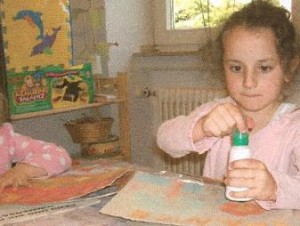 Concluding the book project we invited the parents in order to read out the book to them and the other children in the group. There had to be ice cr ea m served on this occasion (since the difficult “ea” was in that word). We could have had some Schnitzel to go with it, because it had the difficult “sch” in it, but ice cream was more appealing to the children.
Concluding the book project we invited the parents in order to read out the book to them and the other children in the group. There had to be ice cr ea m served on this occasion (since the difficult “ea” was in that word). We could have had some Schnitzel to go with it, because it had the difficult “sch” in it, but ice cream was more appealing to the children.
Note that the “sch” needs much practice because the children don’t recognise the word upon their first attempts to join the letters.
The children all received a certificate documenting their successful participation in the Reading Club.
This and that
It soon became obvious how the ability to read diverged greatly among the children. After the conclusion of the project the children still had the opportunity to improve their reading and writing skills in the group. They were also allowed to make use of the study.
This is a room where small groups or single children may pursue their interests in peace and quiet . There is a PC, books, boxes with equipment for experiments plus specific playing materials. There are also pens, paper and special tables with the initial sounds and the alphabet in capital and lower case letters. These for example are very helpful if a child doesn’t know the lower case letters yet.
Aside from working with the children I lay great emphasis on communication with the school. It is not easy to enrol a child in school if it already knows how to read. Experience has shown that these children easily get bored, especially since the ability to read and the ability to write develop simultaneously.
I hope that these talks result in an exchange of learning materials. We would like to gear our efforts to the reading materials in school so that the children who enrol in school early will encounter familiar texts and books.
I would wish for the children who are already advanced in their reading skills to be allowed to sit in at school, that in some cases an early enrolment even during the ongoing school year is made possible. I could even imagine that joined learning groups composed of children in kindergarten and children in primary school are formed, so that they are not left alone, when they finally enter school.
Date of publication in German: May 5 th, 2007
Translated by Arno Zucknick
Copyright © Silvia Hempler, see Imprint.
